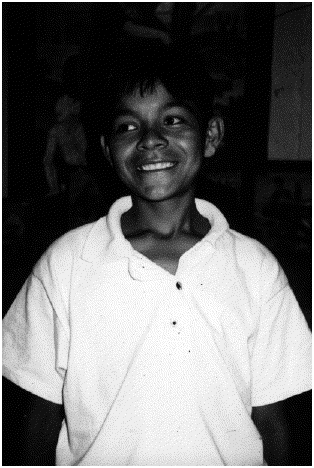Waitress
 My favorite waitress in my favorite
restaurant in Puerto Perdido is named Flor. She's a
pretty little thing, takes orders conscientiously,
brings the food promptly, cleans the table nicely as
we are departing. I always leave her a big tip,
because she is polite, bright --- and nine years old.
My favorite waitress in my favorite
restaurant in Puerto Perdido is named Flor. She's a
pretty little thing, takes orders conscientiously,
brings the food promptly, cleans the table nicely as
we are departing. I always leave her a big tip,
because she is polite, bright --- and nine years old.
When I first started coming here in 1990, Flor's sister Rosa was our waitress. She was only ten, but because of what happened to Rosa, we have great hope for her young sister's future. For Rosa is now enrolled in architecture school in Oaxaca.
When she returned home for vacation at Christmas, she stepped right back into helping her family at the Mayordomo, but told me she will continue in school, and will graduate in two years. She'll go into practice in Puerto Perdido or perhaps in Oaxaca. She positively glowed as she told me some of the intricacies of structure and form, the art of design drawings, the concept of weight-bearing arches.
I was not surprised that this lovely round-faced, soul-eyed young woman had gone into such a career --- from serving red snapper and shrimp al mojo de ajo to, someday, designing buildings. Mexico is changing radically, and the role, future and hope of women are changing even more radically. When Rosa's mother was starting out, running a restaurant and raising a family were about the only fields of employment available to women. However, in the past 10 years, I have met young women in law school, medical school, architecture school and practical engineering.
What in the United States would be a gross violation of the child labor laws is here the norm. I've seen kids of ten or eleven working in their father's tire shop, or fruit stand, or auto repair shop. I still can't figure out who's being hurt more: they or their peers in the United States who --- because of the child labor laws --- are kept off the rolls of the working class.
Many Mexican kids start work at what we think of as a delicate age, in a family enterprise like that of Rosa and Flor. The schools are designed to permit this. Students attend either morning or afternoon classes, with the rest of the day set aside for work.
The average American juvenile, on the other hand, is probably in a school designed along the lines of a prison --- complete with I.D.s and guards --- or sitting at home eating pizza and watching "Jerry Springer" or "Survivor."
If I had my druthers, I'd choose for my child to have the path of Rosa or Flor. They are an honorable part of the family's survival. They work, and they work hard. For many in Oaxaca, there is no television to watch --- the consumer revolution has barely begun here. They also have no shopping mall to visit where they can waste their evenings and get yelled at by security guards.
Most of all, it would be unheard of for the locals to go to a concert with 25,000 peers to smoke dope and watch the Goo Goo Dolls or Pearl Jam; rather, they go to a twice-monthly fiesta with their local band --- Los Chingaderos --- at which there will be 500 people of all ages. The concerts here are a social event for everyone, not a juggernaut for juveniles.
I admit that I've seen children working at jobs that would break your heart. The guy who fixes my tires at the local llanteria is, to my distress, a ten-year-old. His father noisily supervises this backbreaking work while downing the day's seventh or eighth bottle of Corona.
 But for every one of these malfeasances, I have
found dozens of little people helping me with the
carrots and beans at the public market, pumping gas,
serving food at the restaurants, even fixing my
watch, without obvious pain or suffering. The
bartender at El Paradíso --- the Paradise Bar --- is
probably no more than thirteen. He works my hours --- 6
to 10 p.m. His name is the same as mine, Carlos,
and his conversation and philosophy are no better or
worse than the meanderings I used to get from Bud,
at the It'll Do Tavern, back when I was living in the
cold north.
But for every one of these malfeasances, I have
found dozens of little people helping me with the
carrots and beans at the public market, pumping gas,
serving food at the restaurants, even fixing my
watch, without obvious pain or suffering. The
bartender at El Paradíso --- the Paradise Bar --- is
probably no more than thirteen. He works my hours --- 6
to 10 p.m. His name is the same as mine, Carlos,
and his conversation and philosophy are no better or
worse than the meanderings I used to get from Bud,
at the It'll Do Tavern, back when I was living in the
cold north.